
Common name:Kleinia
Botanical name:Senecio mandraliscae
This succulent perennial will grow to about 1.5' tall and 2' wide. It has curved, bluish gray leaves that are about 3.5" long and very slender.

Common name:Century Plant, Maguey
Botanical name:Agave americana
This plant is fast growing to about 6'-10' tall and 8'-13' wide. Wide gray leaves have stiff terminal spines and recurved teeth on margins. It prefers full sun and well-drained situations. After blooming, which could take several years, it will die but will send up new pups from around the base. Some people are allergic to the sap. Removal is difficult if unwanted.

Common name:Blue Fescue
Botanical name:Festuca glauca
This ground cover/grass will grow less than 1' tall and has small, blue green leaves.
Maintenance Tips
Festuca glauca is a perennial clump-forming grass. It has soft straw-like leaves that form a blue-green dome that can get up to about 10 inches wide and tall. They prefer full sun and well-drained soil, but can tolerate slight shade, drought conditions, and poor soil nutrition. These will send out flower stalks in the summer, which should be cut back to the base after a few months to give them a cleaner appearance. They will also benefit from having any dead leaves pulled from the plant at any time of year, but the fall is typically the best time to clean up the foliage. It is short-lived in the landscape, with a lifespan of about 2-4 years after which it dies out in the center. Some might dig up and divide the living edges into several new plants, but most of the time it is easier to replace with a new one.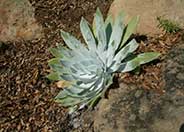
Common name:Chalk Dudleya, Chalk-Lettuce
Botanical name:Dudleya pulverulenta
Chalk Dudleya is a succulent. with 18" diameter rosette and waxy leaves; it has interesting flower spikes.
Maintenance Tips
Dudleya pulverulenta is a dramatic, rosette-shaped succulent that is native to California and Mexico. The plant stays low to the ground, but the individual rosettes can get up to 18" wide. This is one of the most drought-tolerant plants you can have in your garden. It can survive with almost no maintenance, pruning, and even supplemental water once it is established. To keep it looking and performing its best, do not plant it in lower spots in the garden or anywhere that moisture collects. It is pretty unparticular about the soil texture as long as it is well draining. As it matures, the older leaves will collect under the large rosette, and these older leaves can be removed occasionally to keep the plant looking tidy.
Common name:Afterglow Echeveria
Botanical name:Echeveria 'Afterglow'
This succulent perennial is very small, growing only 2"-3" high. It produces orange, pink, and red blooms and does best in full sun and moist soil.
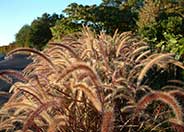
Common name:Purple Fountain Grass
Botanical name:Pennisetum 'Rubrum'
This grass will reach 6' high and has deciduous, purplish red leaves with clusters of purple flowers that appear in summer and fall. Tall grasses are highly combustible.
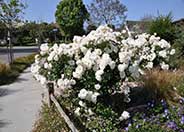
Common name:Iceberg Floribunda Rose
Botanical name:Rosa 'Iceberg'
This is a shrub rose (there are climbing varieties) with an abundance of fragrant, medium sized, white blooms. It is one of the most popular roses and very tough.

Common name:Hybrid Tea Rose (selections)
Botanical name:Rosa Hybrid Tea varieties
These shrubs and vines are the most loved in the Western USA and are very resilient. They come in a wide variety of sizes and colors and are easy to maintain with proper care. They can be used in a water-conserving garden with careful attention to irrigation practices.
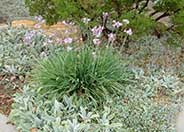
Common name:Society Garlic
Botanical name:Tulbaghia violacea
This clumping perennial will grow less than 1' tall and has narrow, blue green leaves. Clusters of lavender flowers bloom in spring and summer. Leaves and flowers have a distinct onion or garlic smell if crushed.
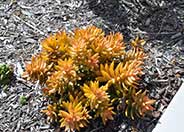
Common name:Orange Sedum
Botanical name:Sedum nussbaumeranian
This succulent perennial will grow best in a wall pot or hanging basket due to its long stems. It has light, gray green leaves that grow over one another to give off a "braided" look. The flowers are pink to deep red and bloom in spring and summer.
Designer: N/A
Photographer: GardenSoft
Maintain a two to four inch layer of mulch on the soil surface to reduce weeds, infiltrate rain water, and reduce compaction.
Remove irrigation water and fertilizer from areas where you don't want weeds to grow.